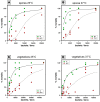Bacillus thuringiensis Spores and Vegetative Bacteria: Infection Capacity and Role of the Virulence Regulon PlcR Following Intrahaemocoel Injection of Galleria mellonella
- PMID: 31060274
- PMCID: PMC6571593
- DOI: 10.3390/insects10050129
Bacillus thuringiensis Spores and Vegetative Bacteria: Infection Capacity and Role of the Virulence Regulon PlcR Following Intrahaemocoel Injection of Galleria mellonella
Abstract
Bacillus thuringiensis is an invertebrate pathogen that produces insecticidal crystal toxins acting on the intestinal barrier. In the Galleria mellonella larvae infection model, toxins from the PlcR virulence regulon contribute to pathogenicity by the oral route. While B. thuringiensis is principally an oral pathogen, bacteria may also reach the insect haemocoel following injury of the cuticle. Here, we address the question of spore virulence as compared to vegetative cells when the wild-type Bt407cry- strain and its isogenic ∆plcR mutant are inoculated directly into G. mellonella haemocoel. Mortality dose-response curves were constructed at 25 and 37 °C using spores or vegetative cell inocula, and the 50% lethal dose (LD50) in all infection conditions was determined after 48 h of infection. Our findings show that (i) the LD50 is lower for spores than for vegetative cells for both strains, while the temperature has no significant influence, and (ii) the ∆plcR mutant is four to six times less virulent than the wild-type strain in all infection conditions. Our results suggest that the environmental resistant spores are the most infecting form in haemocoel and that the PlcR virulence regulon plays an important role in toxicity when reaching the haemocoel from the cuticle and not only following ingestion.
Keywords: Bacillus thuringiensis; Galleria mellonella; PlcR-regulon; bio-pesticide; haemocoel; spores; virulence.
Conflict of interest statement
The authors declare no conflict of interest.
Figures


References
-
- Sanahuja G., Banakar R., Twyman R.M., Capell T., Christou P. Bacillus thuringiensis: a century of research, development and commercial applications. Plant Biotechnol. J. 2011;9:283–300. - PubMed
LinkOut - more resources
Full Text Sources
Molecular Biology Databases
Research Materials

